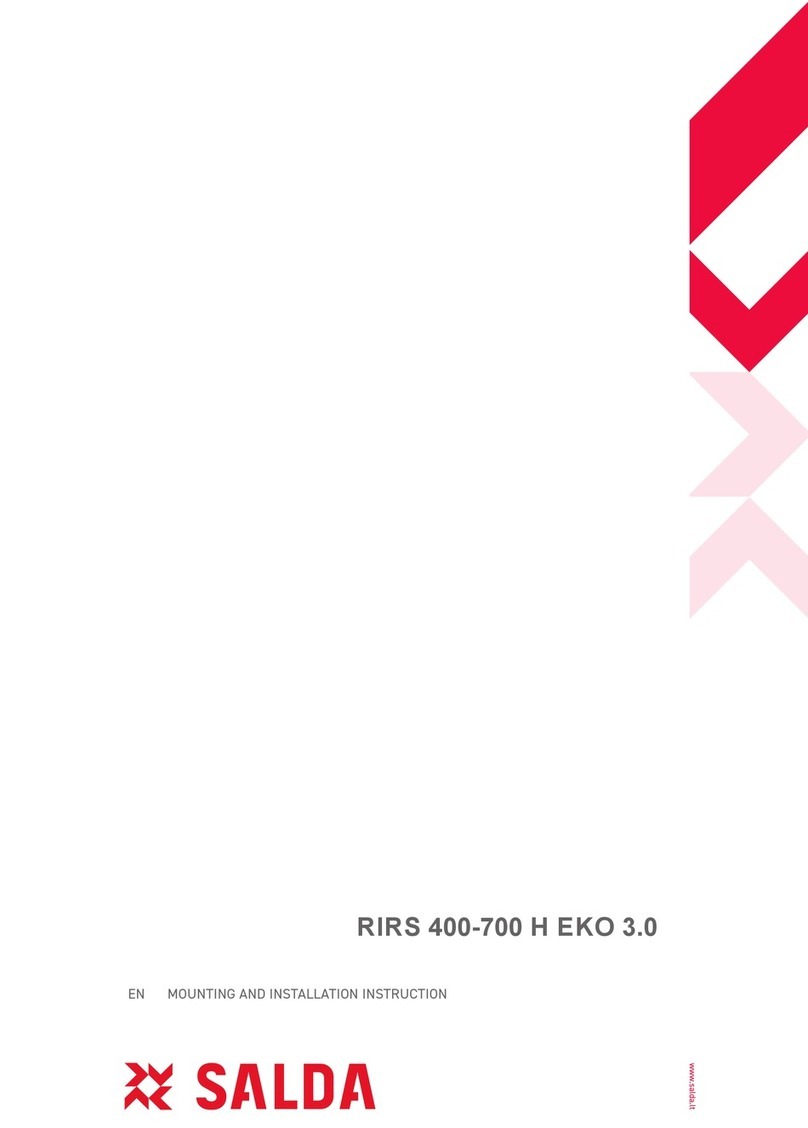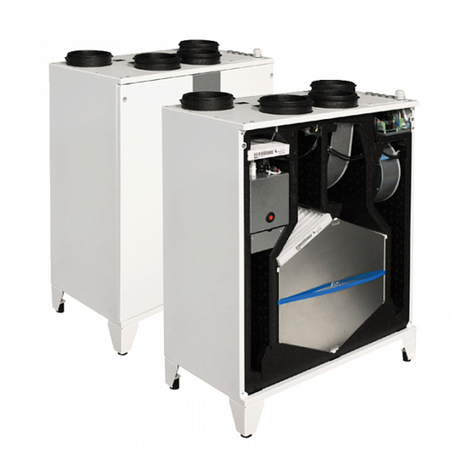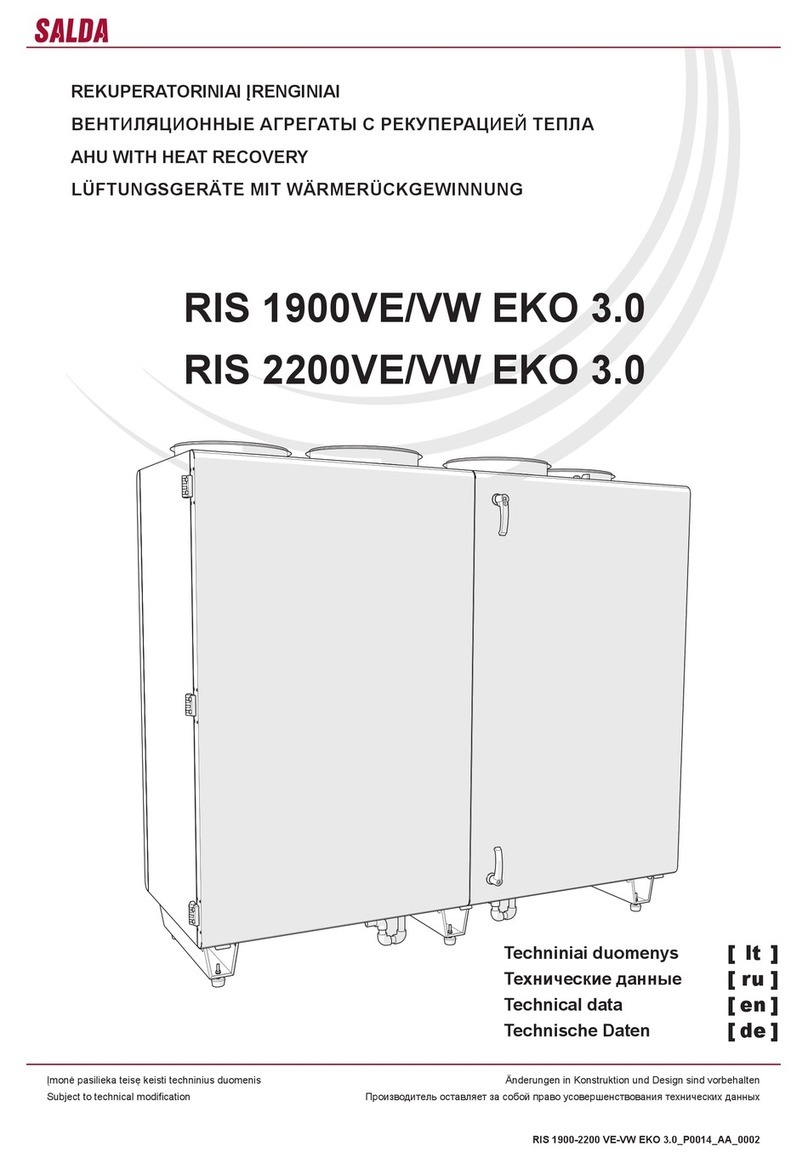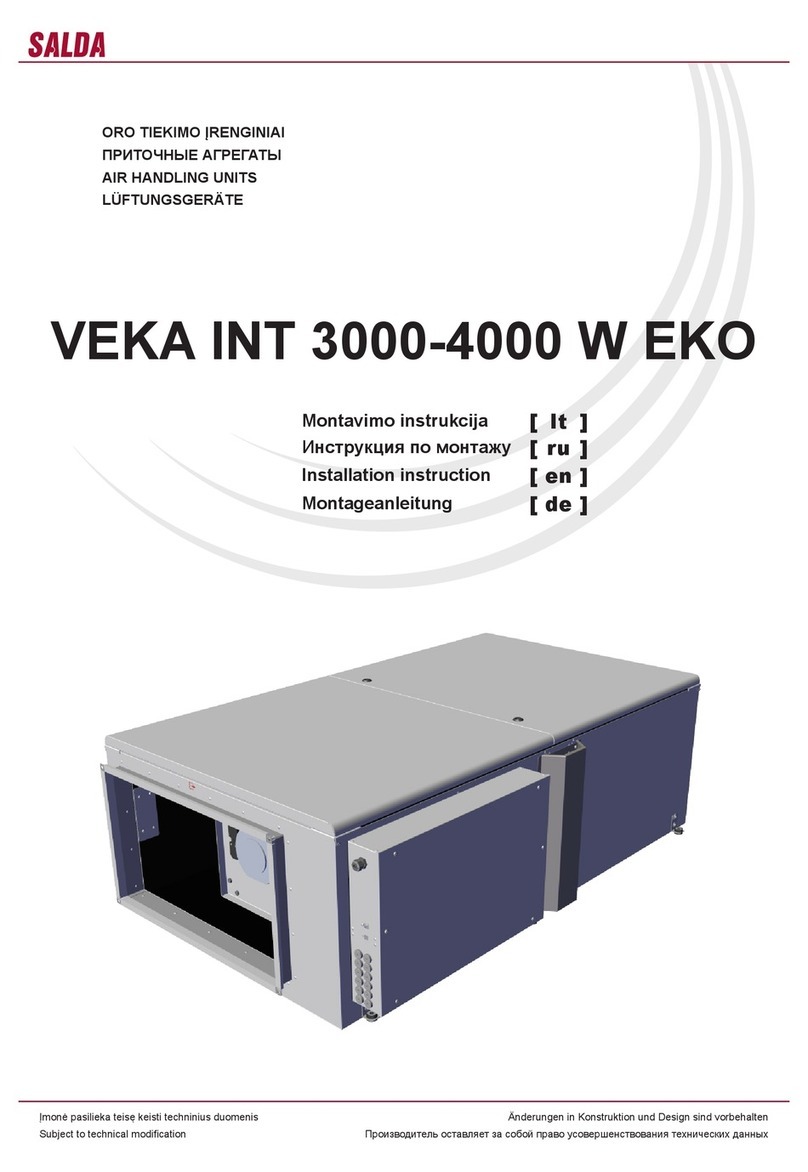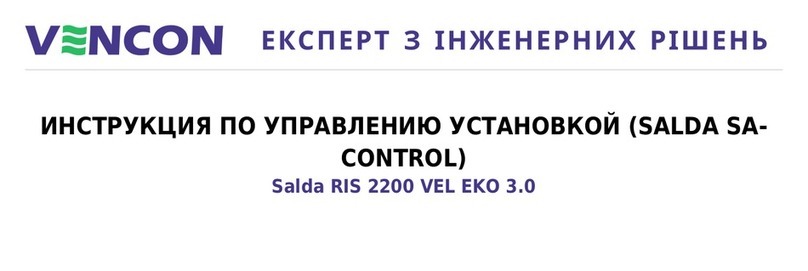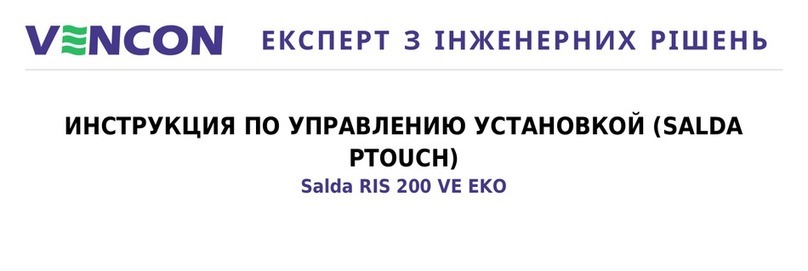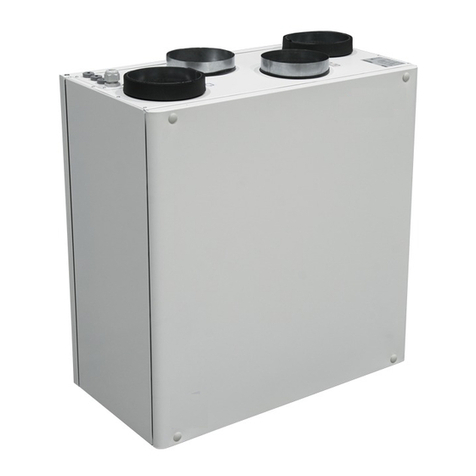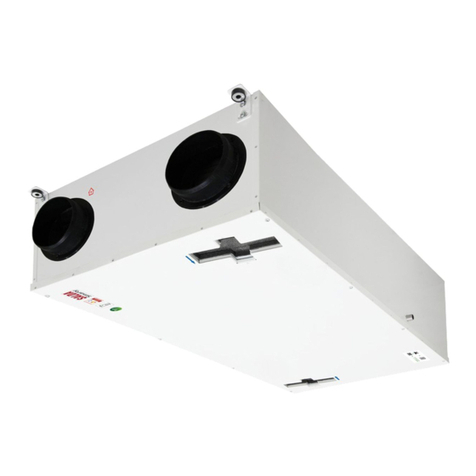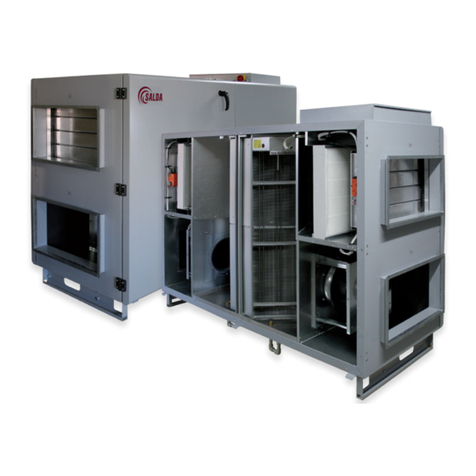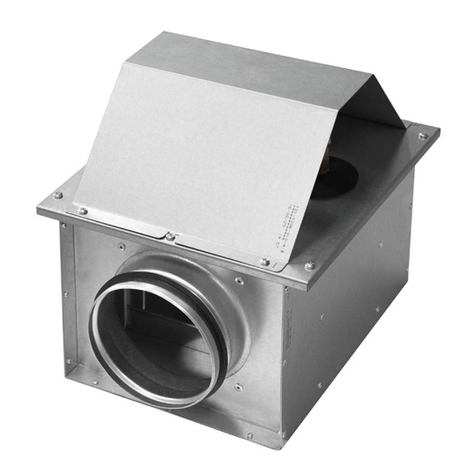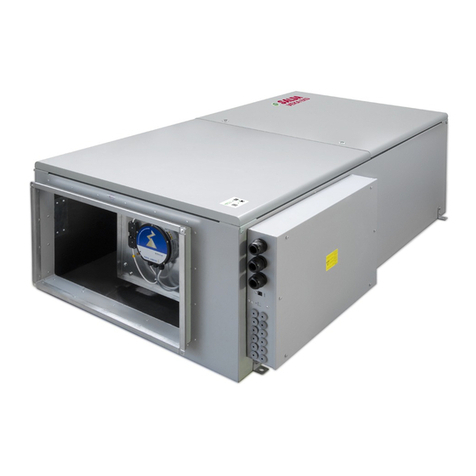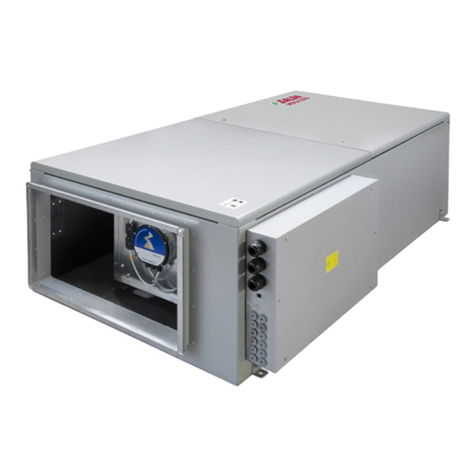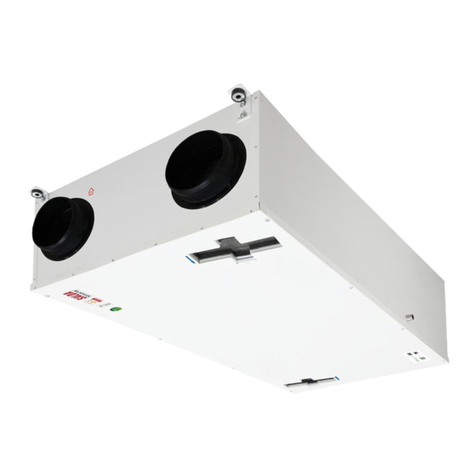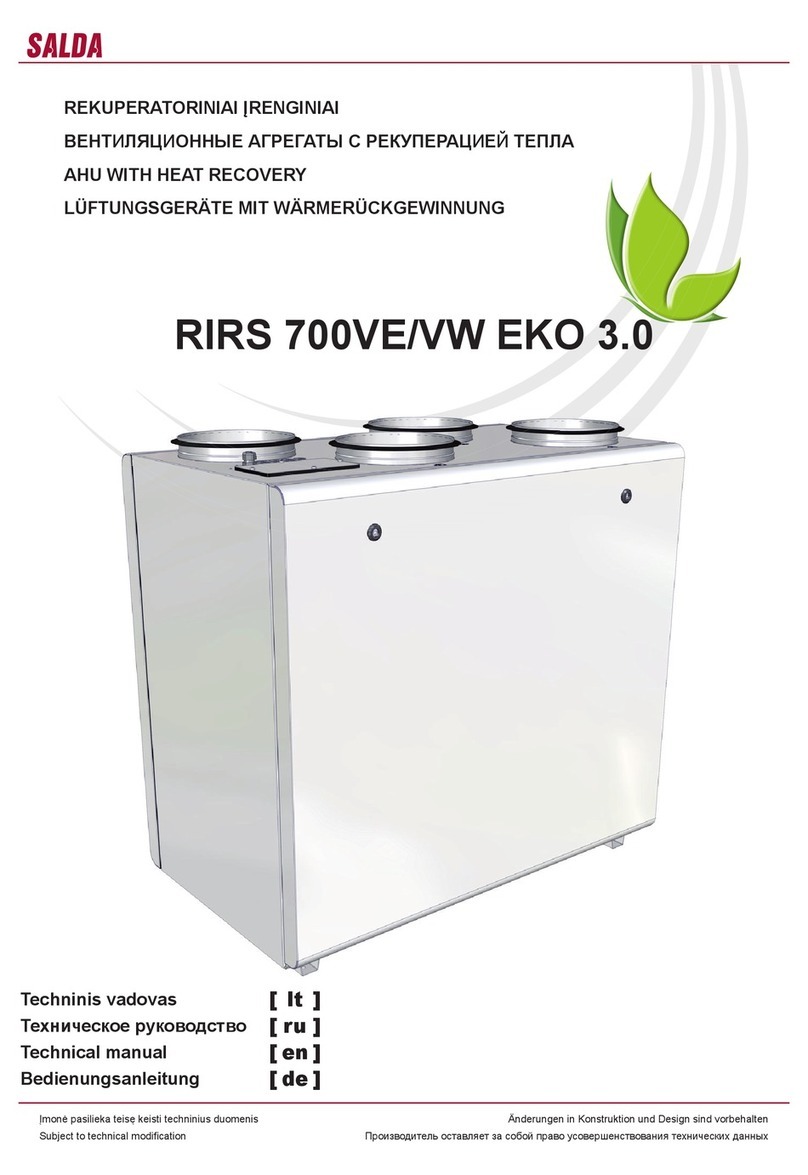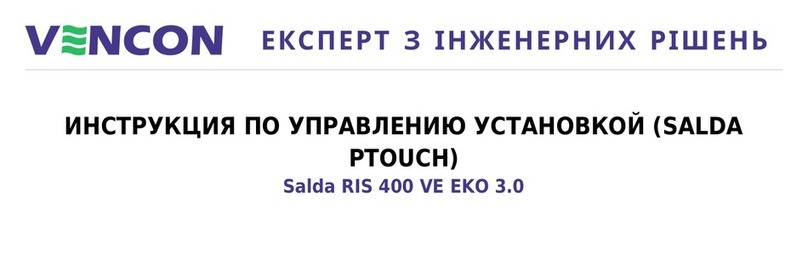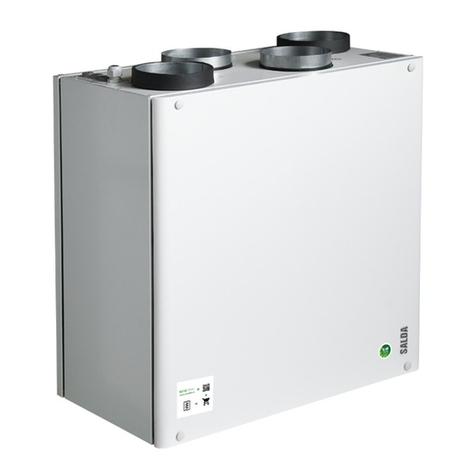
5
www.salda.lt
VEKA INT W EKO
• Монтажные работы могут выполнять только
обученные и квалифицированные работники.
• Устройство должно быть установлено прочно
и жестко, что обеспечит безопасную его экс-
плуатацию.
• Перед подсоединением к системе воздухово-
дов, отверстия вентиляционного устройства
для соединения с воздуховодами должны
быть закрыты.
• Не подсоединяйте колена рядом с монтаж-
ными фланцами устройства. Минимальный
отрезок прямого воздуховода между устрой-
ством и первым ответвлением воздуховодов
в канале забора воздуха должен составлять
1хD, в канале отвода воздуха – 3хD, где D –
диаметр воздуховода. Для прямоугольных воз-
духоводов D=, где B – ширина, а H – высота
воздуховода.
• При подсоединении воздуховодов обратите
внимание на направление воздушного потока,
указанное на корпусе устройства.
• При подсоединении вентилятора к системе
воздуховодов, рекомендуем использовать ак-
сессуары – крепежные обоймы или гибкие со-
единения, в зависимости от типа подключения
устройства (рис. 1). Это уменьшит передачу
вибрации от вентилятора к системе воздухо-
водов и на окружающую среду.
• Монтаж необходимо произвести так, чтобы вес
системы воздуховодов и всех ее компонентов
не нагружал вентиляционное устройство.
• Вибрация может передаваться через пол,
стены или потолок. Если имеется такая воз-
можность, с целью снижения уровня шума
необходимо дополнительно изолировать пол,
стены или потолок.
• Если существует возможность попадания кон-
денсата или воды на двигатель, необходимо
установить наружные средства защиты.
• Приточный агрегат можно устанавливать на
полу или потолке, как указано на рис. 2. Для
этой цели имеются 4 ножки крепления (рис. 3).
• Недопустимая установка устройства показана
на рис. 4.
• ВАЖНО. Устанавливать устройство можно
лишь таким образом, чтобы вся крепящаяся
поверхность устройства полностью прилегала
к монтируемой поверхности. Удалить защит-
ный щит (рис. 5).
• При установке необходимо оставить достаточ-
но места для открывания дверцы обслужива-
ния устройства (рис. 6).
• При недостатке места дверцу обслуживания
можно снять, как показано на рис. 7 а).
• В случае необходимости предусмотрена воз-
можность изменения стороны открывания
дверцы обслуживания устройства (рис. 7).
• При подключении водяного нагревателя масса
водного трубопровода и тепловые напряже-
ния не должны переноситься на патрубки на-
гревателя.
• При монтаже резьбовых соединений труб по-
дачи воды и нагревателей должны использо-
ваться два гаечных ключа (рис. 8).
• Трубопроводы к нагревателю подсоединяются
так, чтобы при проведении работ по обслужи-
ванию и ремонту можно было бы быстро раз-
монтировать и вынуть нагреватель из корпуса
устройства.
• Трубопроводы с подающими и возвратными
теплоносителями должны подключаться так,
чтобы нагреватель работал в направлении,
противоположном направлению движения
воздушного потока. Если нагреватель рабо-
тает в режиме потоков того же направления,
снижается средняя разница температур, вли-
яющая на производительность нагревателя
(рис. 9).
• Смонтируйте датчик температуры приточного
воздуха в канале приточного воздуха. Датчик
устанавливается на максимальном расстоя-
нии от устройства до первого ответвления или
• Installation works shall be performed only by
trained and qualied personnel.
• Unit shall be installed rmly and tightly to en-
sure safe operation.
• Before connecting to the air duct system, the
connection openings of ventilation system air
ducts shall be closed.
• Do not connect the bends near the connec-
tion anges of the unit. The minimum dis-
tance of the straight air duct between the
unit and the rst branch of the air duct in the
suction air duct must be 1xD, in air exhaust
duct 3xD, where D is diameter of the air duct.
For rectangular air ducts D=, where B – width
of the air duct and H – height of the air duct.
• When connecting air ducts, consider the di-
rection of air ow indicated on the casing of
the unit.
• Depending of the type of the unit connection
(Pic 1), it is recommended to use the acces-
sories – clamps or exible connections for
connection of the air supply unit to the air
duct system. This will reduce vibration trans-
mitted by the unit to the air duct system and
environment.
• Installation shall be performed in such man-
ner that the weight of the air duct system and
its components would not overload the ven-
tilation unit.
• Vibration may also be transmitted through
the oor, walls or ceiling. If possible, the oor,
walls or ceiling shall be additionally insulated
in order to suppress the noise.
• The possible access of condensate or water
to the motor shall be prevented by external
protective means.
• Ventilation unit can be installed on the oor
or ceiling as shown in Pic. 2. 4 fastening legs
are supplied for this purpose (Pic. 3).
• Inappropriate way of the unit installation is
shown in Pic. 4.
• IMPORTANT. The unit shall be installed only
in such a way that the entire surface of the
unit fully adhere to the surface of installation .
Remove the protective shield (Pic. 5).
• During installation enough space shall be
retained for opening of the unit maintenance
door. (Pic. 6).
• If there is not enough space, the mainte-
nance door may be removed as it is shown
in Pic. 7 a).
• If necessary, the option to change the open-
ing side of the fan maintenance door is pro-
vided (Pic. 7).
• When connecting the water heater, the
weight of water pipes and heat tensions must
not be transferred on the heater branches.
• When mounting threaded connections of
supply pipes and heaters, two spanners must
be used (Pic. 8).
• Pipes are connected to the heater in such
manner that they could be easily disassem-
bled and the heater could be removed from
the unit casing when performing service or
repair works.
• Pipes with supply and return heat carriers
must be connected in such way that the
heater would work in the opposite direction of
the air ow. If the heater works in the mode of
the same directions, the mean temperature
difference decreases which affects the heater
efciency (Fig. 9).
• Install the supply air temperature sensor to
the supply air duct. The sensor is installed as
far as possible from the unit to the rst branch
or turning of the air ducts.
• Die Montagearbeiten dürfen nur von geschul-
tem und qualiziertem Personal ausgeführt
werden.
• Das Gerät ist fest und starr zu montieren, damit
ein sicherer Betrieb gewährleistet ist.
• Vor dem Anschließen an das Luftleitungssys-
tem sind die Anschlussöffnungen für Luftleitun-
gen abzudecken.
• Schließen Sie keine Bögen in der Nähe von
Geräteanschlussstutzen an. Der Mindestab-
stand einer geraden Luftleitung zwischen dem
Gerät und der ersten Abzweigung in der Zuluft-
leitung muss 1xD, in der Abluftleitung 3xD be-
tragen (D - Durchmesser der Luftleitung). Für
rechteckige Luftleitungen gilt D=, B- Breite der
Luftleitung, H- Höhe der Luftleitung.
• Beim Anschließen der Luftleitungen ist auf
die am Gerätegehäuse angegebene Luftströ-
mungsrichtung zu achten.
• Beim Anschließen des Zuluftgerätes an das
Luftleitungssystem empfehlen wir, Zusatzkom-
ponenten zu verwenden: Bügel bzw. exible
Verbindungen, abhängig von der Anschlussart
des Gerätes (Bild 1). Dies verringert die vom
Gerät an das Luftleitungssystem und die Um-
gebung übertragenen Schwingungen.
• Die Montage ist so durchzuführen, dass durch
das Gewicht des Luftleitungssystems und aller
seiner Bauteile keine Belastungen am Lüf-
tungsgerät auftreten.
• Die Übertragung der Schwingungen kann über
die Fußböden, Wände oder Decken erfolgen.
Besteht diese Möglichkeit, sollten die Fußbö-
den, Wände oder Decken zusätzlich isoliert
werden, um den Lärm abzudämpfen.
• Besteht die Möglichkeit zum Eindringen von
Kondensat bzw. Wasser in den Ventilator, sind
externe Schutzvorrichtungen anzubringen.
• Das Lüftungsgerät kann auf dem Boden oder
an der Decke montiert werden, siehe Bild 2.
Dafür sind 4 Befestigungsfüße vorgesehen
(Bild 3).
• Unzulässige Montage des Gerätes siehe Abb.
4.
• WICHTIG. Das Gerät ist nur so zu montieren,
dass die ganze Befestigungsäche vollständig
auf der Montageäche auiegt. Entfernen Sie
die Schutzscheibe (Bild 5).
• Bei Montage ist ein ausreichender Schwenkbe-
reich für die Wartungstür vorzusehen (Bild 6).
• Ist kein ausreichender Schwenkbereich vor-
handen, kann die Wartungstür abgenommen
werden, siehe Bild 7 a).
• Bei Bedarf besteht die Möglichkeit, die Öff-
nungsseite der Wartungstür zu ändern (Bild 7).
• Beim Anschließen des Wasserheizregisters
darf kein Gewicht und keine Wärmespannun-
gen der Wasserleitungen auf die Stutzen des
Heizregisters übertragen werden.
• Bei Montage von Verschraubungen der Rohr-
leitungen und Heizregister sind zwei Maul-
schlüssel zu verwenden (Bild 8).
• Die Rohrleitungen sind am Heizregister so
anzuschließen, dass sie bei Wartungs- und
Instandsetzungsarbeiten schnell demontiert
werden können, um das Heizregister aus dem
Gerätegehäuse herauszunehmen.
• Der Zu- und Rücklauf der Wärmeübertrager
ist so anzuschließen, dass das Heizregister
in entgegengesetzter Luftströmungsrichtung
funktioniert. Wird das Heizregister in gleicher
Strömungsrichtung betrieben, verringert sich
die mittlere Temperaturdifferenz, die die Leis-
tung des Heizregisters beeinusst (Bild 9).
• Bauen Sie den Zulufttemperaturfühler in die
Fig. 1 Рис. 1 Pic. 1 Bild 1 Fig. 2 Рис. 2 Pic. 2 Bild 2 Fig. 3 Рис. 3 Pic. 3 Bild 3
• Le montage ne peut être effectué que par du
personnel formé et qualié.
• La centrale doit être montée solidement et
fermement an de garantir une utilisation
sûre.
• Avant le raccordement à la gaine de conduits
d’air, les piquages du dispositif de ventilation
doivent être fermés.
• Ne pas raccorder de coudes près des pi-
quages de raccordement de la centrale.
La distance minimale du conduit d’air droit
entre la centrale et la première branche
des conduits d’air doit être de 1xD dans le
conduit d’aspiration et de 3xD dans le conduit
d’extraction de l’air, où D est le diamètre du
conduit d’air. Pour les conduits d’air rectan-
gulaires D=, où B est la largeur du conduit
d’air et H la hauteur du conduit d’air.
• En raccordant les conduits d’air, faire atten-
tion à la direction de ux d’air indiquée sur le
panneau de la centrale.
• Pour le raccordement des piquages à la
gaine de conduits d’air, nous recommandons
d’utiliser des accessoires : les manchettes
ou les raccords exibles en fonction du type
de raccordement de la centrale (Fig. 1). Cela
réduira les vibrations de la centrale sur le
système de conduits d’air et l’environnement.
• Le montage doit être effectué de sorte que le
poids du système de conduits d’air et de tous
ses composants ne surcharge pas le disposi-
tif de ventilation.
• Des vibrations peuvent être transmises par
le sol, les murs ou le plafond. Si possible, il
est nécessaire d’isoler en complément le sol,
les murs ou le plafond an d’étouffer le bruit
causé
• S’il y a la possibilité d’un accès à la centrale
de condensat ou d’eau, il est nécessaire
d’installer des mesures de protection ex-
ternes.
• Il est possible de monter le dispositif de venti-
lation sur le sol ou au plafond comme indiqué
Fig. 2. Quatre pieds de support sont préparés
dans ce but (Fig. 3).
• Il est interdit de monter la centrale comme
indiqué Fig. 4.
• Important : la centrale doit être montée de
telle façon que toute la surface de xage de
la centrale soit complètement collée à la sur-
face de montage (Fig.5)
• Lors du montage, il est nécessaire de laisser
sufsamment de place pour ouvrir les portes
de service de la centrale (Fig. 6).
• En cas de place insufsante, il est possible
d’enlever les portes de service comme indi-
qué Fig. 7 a).
• Si nécessaire, la possibilité est prévue de
changer le côté d’ouverture des portes de
service de la centrale (Fig. 7).
• Lors du branchement de l’aérotherme eau
chaude, la masse de la canalisation d’eau et
les tensions thermiques ne doivent pas être
transférées sur la tubulure de raccordement
de la batterie.
• Lors du montage des connexions des tuyaux
d’alimentation et des batteries taraudés, il
faut utiliser deux clés à écrou (Fig. 8).
• Les tuyaux sont connectés à la batterie de
telle sorte qu’en effectuant les travaux de
maintenance et de réparation il soit possible
de démonter et de retirer rapidement les
tuyaux du panneau de la centrale.
• Les tuyaux avec les caloporteurs d’alimen-
tation et de retour doivent être raccordés de
sorte que la batterie fonctionne dans la direc-
tion inverse au ux d’air. Lorsque la batterie
